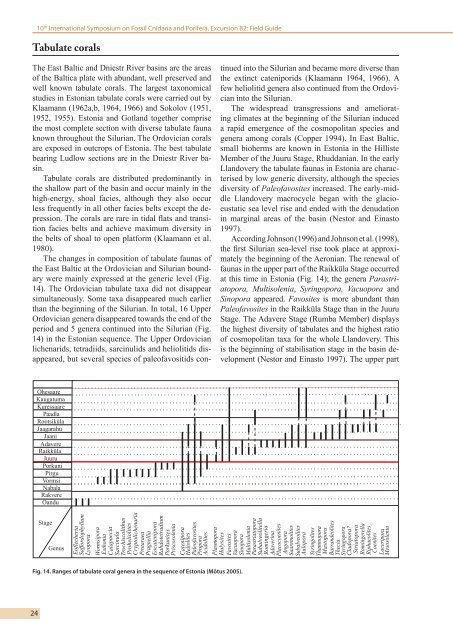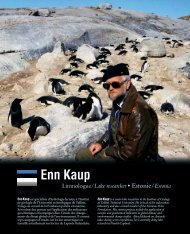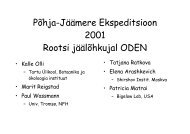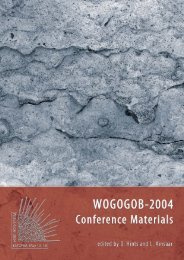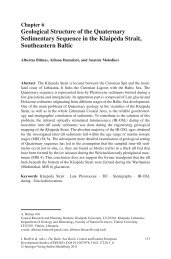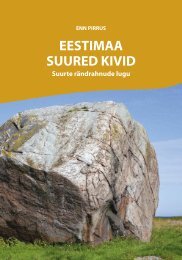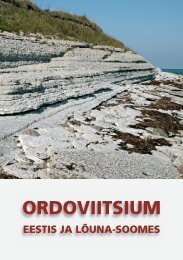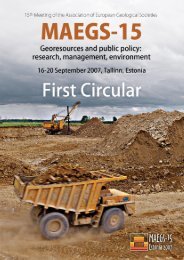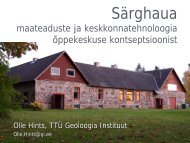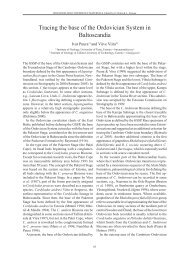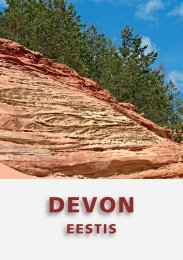EsthoniaCryptolichenariaEocateniporaRabdotetradiumPriscosoleniaProporaAcidolitesPlasmoporaParastriatoporaSubalveolitesAuloporaSyringolitesMastoporaTheciaCladopora?RiphaeolitesMesosolenia10 th International Symposium on Fossil Cnidaria and Porifera. <strong>Excursion</strong> B2: Field GuideTabulate coralsThe East Baltic and Dniestr River basins are the areasof the Baltica plate with abundant, well preserved andwell known tabulate corals. The largest taxonomicalstudies in Estonian tabulate corals were carried out byKlaamann (1962a,b, 1964, 1966) and Sokolov (1951,1952, 1955). Estonia and Gotland together comprisethe most complete section with diverse tabulate faunaknown throughout the Silurian. The Ordovician coralsare exposed in outcrops of Estonia. The best tabulatebearing Ludlow sections are in the Dniestr River basin.Tabulate corals are distributed predominantly inthe shallow part of the basin and occur mainly in thehigh-energy, shoal facies, although they also occurless frequently in all other facies belts except the depression.The corals are rare in tidal flats and transitionfacies belts and achieve maximum diversity inthe belts of shoal to open platform (Klaamann et al.1980).The changes in composition of tabulate faunas ofthe East Baltic at the Ordovician and Silurian boundarywere mainly expressed at the generic level (Fig.14). The Ordovician tabulate taxa did not disappearsimultaneously. Some taxa disappeared much earlierthan the beginning of the Silurian. In total, 16 UpperOrdovician genera disappeared towards the end of theperiod and 5 genera continued into the Silurian (Fig.14) in the Estonian sequence. The Upper Ordovicianlichenarids, tetradiids, sarcinulids and heliolitids disappeared,but several species of paleofavositids con-tinued into the Silurian and became more diverse thanthe extinct cateniporids (Klaamann 1964, 1966). Afew heliolitid genera also continued from the Ordovicianinto the Silurian.The widespread transgressions and amelioratingclimates at the beginning of the Silurian induceda rapid emergence of the cosmopolitan species andgenera among corals (Copper 1994). In East Baltic,small bioherms are known in Estonia in the HillisteMember of the Juuru Stage, Rhuddanian. In the earlyLlandovery the tabulate faunas in Estonia are characterisedby low generic diversity, although the speciesdiversity of Paleofavosites increased. The early-middleLlandovery macrocycle began with the glacioeustaticsea level rise and ended with the denudationin marginal areas of the basin (Nestor and Einasto1997).According Johnson (1996) and Johnson et al. (1998),the first Silurian sea-level rise took place at approximatelythe beginning of the Aeronian. The renewal offaunas in the upper part of the Raikküla Stage occurredat this time in Estonia (Fig. 14); the genera Parastriatopora,Multisolenia, Syringopora, Vacuopora andSinopora appeared. Favosites is more abundant thanPaleofavosites in the Raikküla Stage than in the JuuruStage. The Adavere Stage (Rumba Member) displaysthe highest diversity of tabulates and the highest ratioof cosmopolitan taxa for the whole Llandovery. Thisis the beginning of stabilisation stage in the basin development(Nestor and Einasto 1997). The upper partOhesaareKaugatumaKuressaarePaadlaRootsikülaJaagarahuJaaniAdavereRaikkülaJuuruPorkuniPirguVormsiNabalaRakvereOanduStageGenusEoflecheriaSaffordophyllumLyoporaCalapoeciaSarcinulaProheliolitesProtaraeaPragnelliaPorkunitesCateniporaHeliolitesPaleofavositesHalysitesFavositesVacuoporaSinoporaMultisoleniaSubalveolitellaRomingeriaAdaverinaPlacocoenitesAngoporaSaaremolitesThamnoporaBarrandeolitesStriatoporaRomingerellaCoenitesLaceriporaTrochiscolithusWormsiporaSyringoporaFig. 14. Ranges of tabulate coral genera in the sequence of Estonia (Mõtus 2005).24
10 th International Symposium on Fossil Cnidaria and Porifera. <strong>Excursion</strong> B2: Field Guideof the Adavere Stage in Estonia comprises marl- andmudstones of deeper facies and contains very few corals.Corals are more abundant in the in the Vik Formationin Oslo Region, which is the same age .The major Silurian sea-level rise in uppermostLlandovery is reffered to as the fourth sea-level eventby Johnson et al. (1998). The sea-level lowered againat the beginning of Wenlock The Ireviken event inGotland, which spanned the Llandovery-Wenlockboundary, caused the major extinction of conodontsand trilobites (Jeppsson, 1998). In East Baltic basin,the tabulate fauna changed considerably, new generaappeared (Thecia, Syringolites, Mastopora) and onlyone of the widely distributed Llandoverian species ofPaleofavosites continued from the Adavere Stage intothe Jaani Stage (Klaamann 1970).The species and genera of tabulate corals werehighly diverse and abundant in the Wenlock. Reefsbecame widespread and abundant in mid-continentalNorth America and in the Urals during the Wenlock(Copper and Brunton 1991). The correlation betweenthe carbon isotopic changes and environmental cyclicityin the Silurian of East Baltic was investigatedby Kaljo et al. (1998). The sea-level declines, associatedwith glaciations, were periods of more vigorouscirculation and enhanced oxygenation of ocean-bottomwaters. The relationship between the positivecarbon isotopic peaks and intensive reef growth inGotland has been confirmed by Sambtleben et al.(1996). The conditions for corals were more favourablein Gotland than in Estonia. Spectacular reefsrich in tabulate corals occur in the Högklint Formationon the northern coast of Gotland (Laufeld andMartinsson 1981). The high-energy shoal facies,which are the most favourable for corals, were absenton Saaremaa at that time. Smaller biostromes ofopen shelf facies, rich in heliolitids and halysitids,were spread instead in the Jaani Beds, Ninase Member(Mõtus 2006).The Jaagarahu Stage in Estonia is characterised bythe largest generic diversity of tabulates in the Wenlock(Fig. 14). The most widespread tabulates werefavositids, theciids and coenitids. Palaeofavositesdominated many bioherms on Gotland and was alsoabundant on Saaremaa.The global sea level fall culminating near the topof the Cyrtograptus lundgreni Zone and the followingrapid transgression in Gothograptus nassa-Pristiograptusparvus Zone is marked by transgressiveoolites in lowermost Halla Formation on Gotland(Calner 1999, Calner and Säll 1999). A global extinctionand disappearance of graptolites, conodonts, chitinozoansand shelly fossils, named the Mulde eventby Jeppsson (1998), also affected the reefs on Gotland.The low-diversity biostrome from the Halla Beds ofBlåhäll 1 is the first re-appearance of reefs on Gotlandafter the Mulde event. A common feature of the Hallaand Mulde Formations as well as for the middle of theKlinteberg Formation is their small size (Klaamannand Einasto 1982). A lowering of the sea at the end ofthe Wenlock is suggested from the appearance of thelagoonal facies in the Rootsiküla Stage on Saaremaa,which contains abundant branching parastriatoporids(Klaamann 1986).The diversity of tabulate corals in Estonia was lowduring the Ludlow Epoch (Fig. 14), when the sea wasnarrowing in Baltoscandia. The high-energy shoal facieswith more favourable conditions for corals existedin Gotland, in the Dniestr River Basin and inthe Podljassk-Brest area. Heliolitids and halysitidsare not found in the Ludlow successions in Estonia,although the former reached the end of Devonianelsewhere and halysitids have been found in the Ludfordianin Gotland and also in the Pridoli of SouthernGaspe Peninsula in Canada. Disappearance of Theciaand Subalveolitella is recorded in Estonia at theend of the Wenlock, but they occur in Ludlow of theDniestr River Basin. Large reefs were characteristicof this time in Gotland and Podolia.The halysitids from the Eke Formation in Gotlandare the youngest in Baltoscandia (Mõtus and Sandström2005). The Lau event is one of the largest extinctionevents among conodonts, graptolites, chitinozoans,some fishes, and brachiopods (Jeppsson 1998).It is noteworthy that the halysitids survived the earlyparts of the Lau extinction event in Gotland.Favosites vicinalis Klaamann, 1962,from Kaugatuma cliff, Saaremaa Island(<strong>Excursion</strong> Stop 19)25


